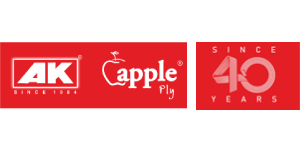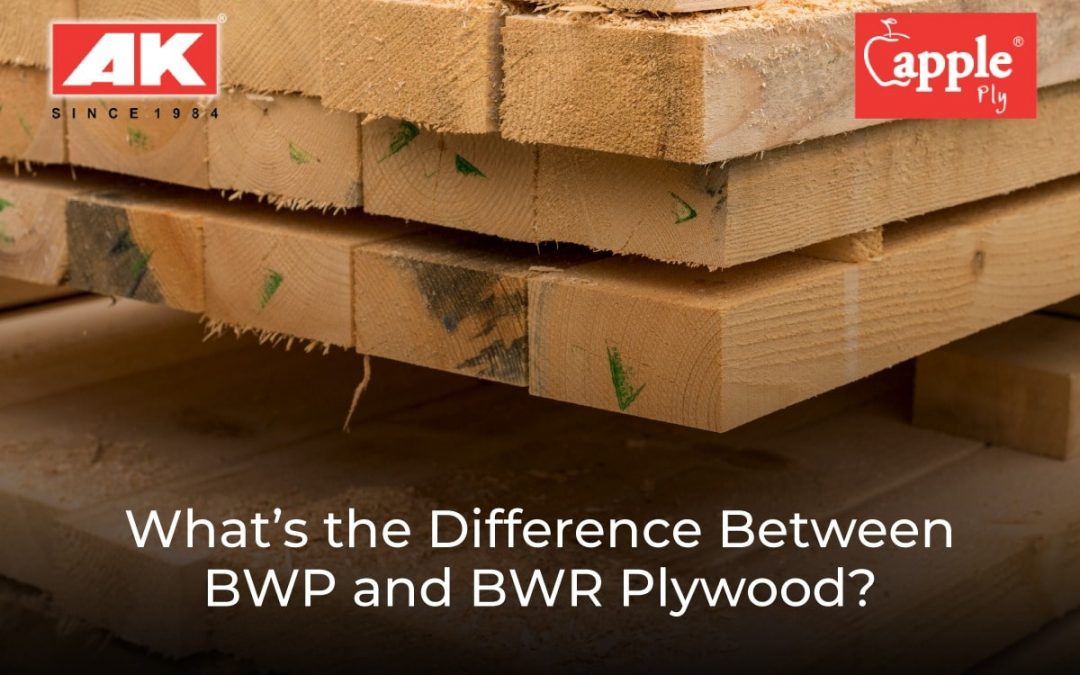The puzzle of building something new can be exciting, can’t it? However, choosing the right materials is crucial to bringing your vision to life.
When it comes to plywood, two popular options stand out: BWP and BWR Plywood. Understanding the differences between these two is key to crafting furniture or building structures that last.
So, to assist you all with choosing the right option between BWP and BWR plywood we’ve put together this guide.
Let’s find out and see which one is best for you.
What is the Difference Between BWP and BWR Plywood?
When it comes to choosing the right plywood for your project, understanding the differences between BWP and BWR plywood is crucial. Let’s break down the key differences between these two types of plywood.
BWP (Boiling Water Proof) Plywood
Purpose: Designed for water-intensive or all-weather use, making it ideal for outdoor applications or areas exposed to high humidity.
ISI Grade: IS:710
BWR (Boiling Water Resistant) Plywood
Purpose: Suitable for interior applications exposed to moisture, such as kitchens and bathrooms.
ISI Grade: IS:303
Understanding Blockboard vs Plywood
The debate often centers around blockboard vs plywood when it’s about choosing the right material for your project. Both have their unique characteristics, advantages, and uses. Let’s dive into the details of each.
1. Blockboard
Blockboard is a type of engineered wood made from:
- Made from Softwood strips:
- Stronger and less flexible
- Suitable for doors, large shelves, and heavy-duty furniture
Note: Blockboard’s strength and rigidity make it perfect for projects that need to support heavy loads.
2. Plywood
Plywood, on the other hand, is made from:
- Layers of wood veneer under high pressure
- More flexible and easier to shape
- Commonly used in: Modular furniture and cabinetry
📝Note: Plywood’s flexibility and ease of shaping make it a popular choice for projects that require intricate designs or curved shapes.
Related blog: Blockboard vs Plywood: Key Differences Every Buyer Should Know.
Key Features of BWP vs BWR Plywood
Whenever you get stuck in choosing between BWP and BWR plywood, the only solution it holds is – to know what sets them apart. Let’s take a look into some of the features of each and explore which one is best suited for your project.
Features of BWP Quality Blockboard: The Ultimate Durability Champion
BWP plywood is a top-notch choice for projects that require extreme durability. Here are some of its standout features:
- Constructed using phenolic and melamine glue: This special adhesive makes AK Plywood BWP highly resistant to water, termites, and pests.
- High resistance to water: AK Plywood BWP can withstand prolonged exposure to water, making it perfect for outdoor or high-humidity applications.
- Durable in all weather conditions: Whether it’s scorching heat or pouring rain, AK Plywood BWP can handle it all.
Features of BWR Plywood: The Perfect Choice for Humid Areas
BWR plywood, on the other hand, is designed for interior applications that require moisture resistance. Here are some of its key features:
- Resistant to warping: AK Plywood BWR maintains its shape and structure even in humid conditions.
- Malleable and easy to work with: AK Plywood BWR is a dream to work with, allowing you to shape and design with ease.
- No core gaps: This ensures a smooth, even surface that’s perfect for finishing.
- Ideal for kitchens, bathrooms, and other humid areas: BWR plywood is a popular choice for the best plywood for kitchen cabinets from AK Plywood, especially in areas prone to moisture.
Whether you choose AK Plywood BWP or AK Plywood BWR, you can trust that you’re getting high-quality plywood that meets your specific needs.
Uses of BWP Blockboards and BWR Plywood: Where to Use Them?
Let’s dive into the various applications of BWP and BWR plywood and explore where they shine.
BWP Blockboards Applications: Built to Last Outdoors
BWP blockboards are perfect for projects that require extreme durability and water resistance. Here are some popular BWP blockboard advantages:
- Outdoor patio furniture
- Bathroom and kitchen shelves
- Doors and frames in wet environments
BWR Plywood Applications: Perfect for Interior Projects
BWR plywood, on the other hand, is designed for interior applications that require moisture resistance. Here are some popular BWR plywood uses:
- Kitchen cabinets and drawers
- TV units, wall units, wardrobes
- Shoe racks, semi-outdoor furniture
BWP vs BWR Plywood: Which One Should You Choose?
Here comes a million-dollar question! Deciding between BWP and BWR plywood ultimately depends on your specific needs and priorities. To make an informed decision, ask yourself these two key questions:
Ask Yourself Two Key Questions
1. What is the use-case?
- Heavy-duty applications: If you’re working on a project that requires extreme strength and durability, BWP plywood is the way to go. Think outdoor furniture, construction, or high-traffic areas.
- Interior modular work: For interior projects that require moisture resistance, BWR plywood is a great choice. It’s perfect for kitchen cabinets, bathroom fixtures, or other areas that need a touch of elegance and durability.
2. What is your budget?
- BWR is more affordable: If budget is a constraint, BWR plywood might be the more feasible option. It still offers great moisture resistance and durability, but at a lower price point.
- BWP offers longer lifespan and higher strength: While BWP plywood might be more expensive upfront, its longer lifespan and higher strength make it a worthwhile investment for projects that require extreme durability.
So, which is better, BWR or BWP? The answer depends on your specific needs and priorities. By considering the use-case and budget, you can go for the plywood that suits your project requirements. Whether you choose BWP or BWR, make sure it aligns with your goals and delivers the results you’re looking for.
How to Identify BWP and BWR Plywood?
When shopping for plywood, it’s essential to know how to identify BWP and BWR grades. Let’s break it down in simple terms.
ISI Standards to Look For
The Indian Standards Institution (ISI) certification is a guarantee of quality. Here’s what to look for:
- IS:710: If you see this mark on AK Plywood IS:710, you can be sure it’s BWP grade, designed for extreme water resistance and durability.
- IS:303: This mark indicates BWR grade, suitable for interior applications that require moisture resistance.
Related blog: IS 303:2024 vs IS 710:2024: What You Need to Know About the Latest Plywood Standards.
Visual and Physical Indicators
Apart from the ISI mark, you can also identify BWP and BWR plywood by their physical characteristics:
BWP Plywood:
- Feels heavier and stiffer due to its denser construction.
- Perfect for projects that require extreme durability and water resistance.
BWR Plywood:
- More flexible and easier to handle, making it ideal for interior projects.
- Still offers great moisture resistance, but not as robust as BWP.
Maintenance Tips for Long-Lasting Performance
To ensure your BWP and BWR plywood lasts for years to come, regular maintenance is key.
How to Maintain BWP Plywood? BWP plywood is built to last, but a little TLC goes a long way. Here are some tips to maintain your BWP plywood:
- Regular Cleaning
- Avoid Long Water Exposure
- Check for Damage
- Use Coasters & Mats
- Seal Joints and Edges
How to Maintain BWR Plywood?
BWR plywood is perfect for interior applications, but it still needs some love to last. Here are some tips to maintain your BWR plywood:
- Dust Regularly
- Manage Moisture
- Avoid Direct Sunlight
- Use Furniture Pads
- Avoid Harsh Cleaners
Common Mistakes to Avoid When Choosing Plywood: Don’t Get Caught Out!
It’s easy to get caught up in the excitement and make some costly mistakes. But you shouldn’t! Let’s highlight some common pitfalls to avoid:
Choosing Based Only on Cost: Don’t Compromise on Quality
While budget is an essential consideration, choosing plywood solely based on cost can lead to subpar results. Cheaper plywood might not offer the same level of durability, water resistance, or structural integrity as higher-quality options.
Ignoring ISI Certifications: Ensure You’re Getting the Real Deal
ISI certifications are a guarantee of quality and adherence to Indian standards. Ignoring these certifications can lead to plywood that doesn’t meet your project’s requirements. Always look for the ISI mark to ensure you’re getting plywood that meets the necessary standards.
Using BWP Where Flexibility Is Needed: Know Your Plywood’s Strengths
BWP plywood is incredibly durable and water-resistant, but it’s not the most flexible option. Using BWP in applications where flexibility is crucial can lead to cracks, breaks, or other damage. Make sure to choose the right type of plywood for your project’s specific needs.
Environmental Considerations When Choosing Plywood: Make a Sustainable Choice!
It’s not just about functionality and aesthetics – it’s also about the environmental impact That’s why it’s important to keep environmental considerations in mind when choosing a plywood. Let’s explore why sustainable plywood options are a great choice for the planet and your well-being.
Why Go for Sustainable Products? Do Good, Feel Good!
Choosing sustainable plywood products has numerous benefits, including:
- Less deforestation
- Healthier indoor air quality
- Durable, long-term investment
Choose FSC-Certified Brands Like AK Plywoods: The Eco-Friendly Choice
AK Apple Plywoods is a great example of a brand that prioritizes sustainability. By choosing FSC-certified products like AK Plywoods, you’re supporting:
- Eco-friendly and ethically sourced materials
- Low-emission adhesives and sustainable manufacturing practices
Why Choosing the Right Plywood Matters? Get it Right, Get it Bright!
To come up to a conclusion, understanding the difference between BWP (Boiling Water Proof) and BWR (Boiling Water Resistant) plywood is essential. BWP plywood is ideal for exterior applications or areas prone to moisture, while BWR plywood is suitable for interior applications.
Moreover, if you’re looking for high-quality BWP plywood, buying online in India is a great option. You can compare prices, check reviews, and get doorstep delivery – all from the comfort of your couch.
AK Plywood: Waterproof Plywood Manufacturer in India
When it comes to waterproof plywood, it’s essential to choose a reputable and waterproof plywood manufacturer in India like AK Apple Plywood. We use high-quality materials, follow sustainable practices, and offer certifications like ISI and FSC.
Why Choose the Right Plywood?
Choosing the right plywood matters because it can:
- Ensure durability and longevity
- Provide aesthetic appeal and design flexibility
- Support sustainable practices and reduce environmental impact
- Offer better indoor air quality and healthier living spaces
Get the Best Plywood for Your Project
Ready to get started? Buy BWP plywood online in India from a trusted waterproof plywood manufacturer and ensure your project turns out exactly as you envisioned.
Get a Quote Today and take the first step towards creating something amazing!
Frequently Asked Questions (FAQs)
1. How do BWP and BWR plywood differ in terms of water resistance?
BWP (Boiling Water Proof) plywood is more water-resistant than BWR (Boiling Water Resistance) plywood. BWP plywood can withstand prolonged exposure to water, while BWR plywood offers good water resistance but may not be as durable in extreme conditions.
2. Are there differences in durability between BWP and BWR plywood?
Yes, BWP plywood is generally more durable than BWR plywood due to its higher water resistance and stronger adhesive properties.
3. How does the manufacturing process affect the properties of BWP and BWR plywood?
The manufacturing process involves using different types of adhesives and manufacturing techniques to achieve the desired level of water resistance. BWP plywood is made with a stronger adhesive and undergoes a more rigorous manufacturing process, making it more durable and water-resistant.
4. Is BWP plywood fire-resistant?
BWP plywood is not necessarily fire-resistant. While it offers excellent water resistance, its fire resistance depends on additional treatments or coatings.
5. Which is better, 303 or 710 plywood?
It depends on the application and specifications; 710 plywood may offer better durability and water resistance, but check manufacturer details to determine the best fit.
Dr. Prasanth M.A. is the Director of AK Applye Plywood, a trusted name in the plywood and interior solutions industry. With over a decade of expertise in wood technology and sustainable manufacturing, he is passionate about delivering high-quality, innovative plywood products that meet both functional and aesthetic needs. Dr. Prasanth is committed to promoting eco-friendly materials and has been a key figure in driving industry best practices in durability, design, and customer-centric solutions. Under his leadership, AK Applye Plywood has grown into a brand synonymous with quality craftsmanship and reliability in the Indian plywood market.




